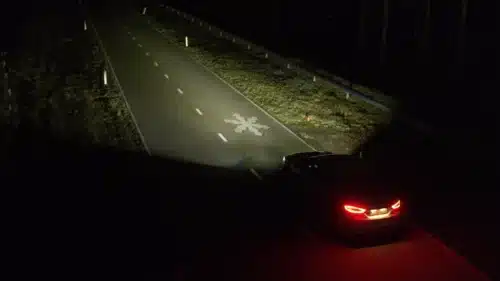“High-resolution” headlights that can project signs and data such as weather information, directions, and speed limits directly in the driver’s line of sight.
A study conducted by Britain’s Royal Society for the Prevention of Accidents suggests that 40% of collisions occur in the hours of darkness, when vision is reduced and it becomes more difficult to see road users such as pedestrians, cyclists, and motorcyclists.

To tackle such events, Ford Europe is working on what it calls “high-resolution” headlights that do more than just illuminate the road. These headlights are capable of projecting signs and other information such as directions, speed limits, and weather information directly in the driver’s line of sight. Therefore allowing the driver to focus his gaze on the road only.
The headlights are linked to the infotainment’s navigation system which enables the system to display upcoming turns on the road. This technology is based on existing head-up displays (HUDs) that project helpful information on the windshield in front of the driver. Ford advances in the same domain by using the headlights to project information onto the road in front of the vehicle using augmented-reality (AR) technology
Lars Junker, features and software, Advanced Driver Assistance Systems, Ford Europe, says “What started as playing around with a projector light and a blank wall could take lighting technologies to a whole new level. There’s the potential now to do so much more than simply illuminate the road ahead, to help reduce the stress involved in driving at night. The driver could get essential information without ever needing to take their eyes off the road.”
Mercedes-Benz already offers similar tech on its Mercedes-Maybach S-Class vehicles called Digital Light which allows the projection of guidelines or warning symbols onto the road ahead. The Digital Light’s light module consists of three LEDs in each headlamp whose light is refracted and directed by 1.3 million micromirrors. A control unit with a graphic processor uses an HDMI-like connection to generate a continuous video stream to the mirrors. In this sense, Digital Light uses the technology of video projectors.
The beam is divided into 1.3 million pixels therefore providing precise distribution of light beam. This according to Mercedes makes the HighBeam Assist 100x more precise than an 84-pixel light when excluding oncoming traffic or road signs from the light beam.
Digital Light assists the driver via the following functions:
- Warning of recognized roadworks by projecting an excavator symbol onto the road surface.
- Aiming a spotlight at pedestrians detected at the roadside.
- Traffic lights, stop signs, or no-entry signs are pointed out by projecting a warning symbol onto the road surface.
- Assistance on narrow road lanes (roadworks) by projecting guidelines onto the road surface.






